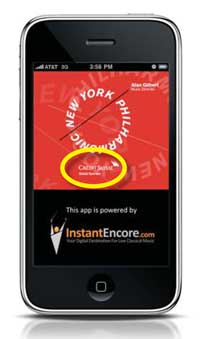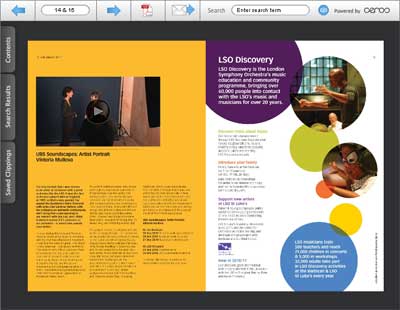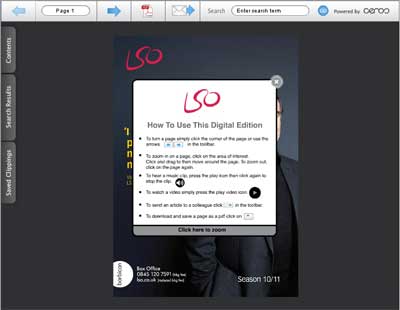During the COVID-19 pandemic, many who had the option began to work from home or work remotely as a safety precaution. Apollo Technical conducted a survey which suggests that in May 2020, over 26% of employed individuals worked from home. Over the course of the pandemic, that number increased to about 70%. Technology is capable of incredible things, making this remote work possible without the presence of an office or communal workplace. For musicians however, this is a different story.
Using Apps for Orchestra Audience Engagement
As people continue to spend more and more time on their phones, up to 5.4 hours a day for the average phone owner in the U.S., orchestras are increasingly turning to apps for news ways to engage their audiences. When used effectively, smartphone applications have the potential to invite new audiences into the hall while heightening the stickiness of the most loyal subscribers. This article addresses their primary benefits and best practices for implementation.
Orchestras' Post-Pandemic Digital Future
There is no use in waiting for the world to “go back to normal”: orchestras need to keep pushing forward and adjusting to the new reality. Covid-19 has proven, yet again, that people are interested in classical music, that it can and should have a stronger online presence, and that it has the power to bring peace—especially in times of uncertainty. Orchestras need to stake their place and assert their relevance in society. I envision a world where orchestras operate using “two stages”: one physical and one digital.
To Tweet Seat or Not To Tweet Seat: An Insider's Perspective
The year has come full circle for me and tweet seats. From my first conversation about them last summer at the Theatre Communications Group Annual Conference to the CMU School of Music’s tweet seat initiative this past spring, the last twelve months provided an opportunity to play with this still new (and at times, controversial) audience engagement tool.
CMU School of Music Tries Tweet Seats
On January 26, 2014, Carnegie Mellon University’s School of Music offered a little something extra to its audience both in Pittsburgh and afar: tweet seats. Last summer I wrote an article about tweet seats that provides an overview of decisions that need to be made before implementing this heavily debated audience engagement technique. With this advice in mind, the School of Music set out to define how and why tweet seats might be a good idea for live concerts.
Research Update #3: Creating Online Audiences For Orchestras
In my last research update, I illustrated some of the most important opportunities and benefits associated with the creation of online audiences. But as arts managers consider how to create these online audiences, they should also be aware of a variety of challenges and potential risks associated with doing so. Here are a few:
To Tweet Seat or not to Tweet Seat: A Perspective
To tweet seat or not to tweet seat; that’s the question on everyone’s mind. After a rather engaging conversation at the Theatre Communications Group Annual conference in Dallas, I went home thinking about the pros and cons of new technology and how it can be used to engage today’s audience. If our audiences are evolving, why are we still connecting with them in the same manner as the previous generation of administrators?
The Peril of Tweet Seats
Stop me if you’ve heard this one – your local symphony has an upcoming production, and in order to draw in a younger crowd offer Tweet Seat tickets. The young kids come, spend the performance merrily on their phones, and head home. The next week, the symphony is slapped with a cease and desist – wait, what? I’ll start at the beginning. Tweet Seats are a new engagement tactic for performing arts organizations, utilizing social media and modern technology. The idea is that some seats in your house are reserved for people who wish to utilize their phone during the show. These patrons use Twitter or other social media to discuss and engage the performance at hand. Usually these seats are less expensive and in the back of the house, so as to not disturb the other patrons.
Some people (read: me) love the idea – others hate it, and the most thoughtful question its ability to truly increase engagement. Regardless, Tweet Seats are here to stay. Huffpo has written on them, Wolf Trap has used them, and now some troll claims to have successfully patented them.
The story dropped back in March, but it’s still very relevant to anyone considering using Tweet Seats in an upcoming production. Inselberg Interactive is the company holding the patent, whose language refers specifically to sporting events, but they have already demanded license fees from a nonprofit theatre in Connecticut. Ars Technica has the full story and analysis, but it basically boils down to this:
The company holding the patent doesn’t claim to have invented the smart phone technology or the social media apps Tweet Seats utilize. They claim to have invented the process of, I don’t know, tweeting at live events. Still with me? Good.
Patents, according to the US Patent and Trademark Office protect inventions and improvements to existing inventions. They also, according to my one semester of law class, must be novel and non-obvious. This patent was issued in 2005: Twitter didn’t exist and baby Facebook was just starting to let high school students in. At that time, this probably was a novel idea – but it was just an idea. Patents don’t usually apply well to ideas, they need a more tangible form.
Patents can be challenged and litigated against, but that costs time and legal fees. Given that this troll has turned their focus to the non-profit world, it’s unclear if those are available resources.
And when you consider that patents have a minimum shelf life of 14 years, I don’t think it’ll be going away unless someone smacks them down in court.
Instant Encore: Classical Music goes Mobile

- Margo Drakos, co-founder/COO of InstantEncore
Margo Drakos is a woman on a mission. The co-founder and COO of InstantEncore wants to take classical music directly to its audience via a host of online services, including a digital strategy package for powering custom websites for organizations, a website builder for artists and the development of mobile apps. Recently, the company has been busy building custom mobile apps for Android, iPad, iPhone and all smartphones. InstantEncore’s mobile apps have previously been featured on this blog in Tom’s article 10 Arts and Culture Mobile Apps from 2010.
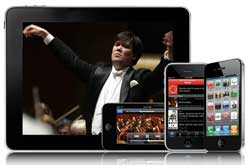 InstantEncore currently powers about 100 iPhone apps and 50 Android as well as hosting mobile web apps, which make an organization's website functional on a mobile phone. Their platform powers the app for the popular YouTube Symphony Orchestra, which, at over 125,000 downloads, and beats both the Taylor Swift and Linkin Park apps by about 90,000. Instant Encore also hosts the apps of notable organizations like the NY Philharmonic, Chamber Music Society of Lincoln Center, Cleveland Institute of Music and Houston Grand Opera.
InstantEncore currently powers about 100 iPhone apps and 50 Android as well as hosting mobile web apps, which make an organization's website functional on a mobile phone. Their platform powers the app for the popular YouTube Symphony Orchestra, which, at over 125,000 downloads, and beats both the Taylor Swift and Linkin Park apps by about 90,000. Instant Encore also hosts the apps of notable organizations like the NY Philharmonic, Chamber Music Society of Lincoln Center, Cleveland Institute of Music and Houston Grand Opera.
I talked with Margo recently to catch up on Instant Encore's latest endeavors.
What is InstantEncore? InstantEncore.com is a classical music platform that enables artists and arts organization to harness the power of technology to connect with their fans anywhere, any time. We are the infrastructure! We have created the only classical music-specific digital asset management system that essentially allows our Partners from a broad spectrum of the performing arts world to enter digital content – event listings, ticket selling, audio recordings (streaming, download, public or private), video (live or on-demand), news, blogs, and photos - one time, and have all of their content published in real time to their own website, mobile apps, Facebook or Twitter accounts.
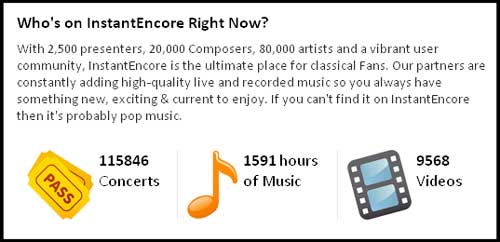 How did the idea for InstantEncore come about?
Two things happened: I was playing cello for a living and I had sort of grown frustrated with the disconnect between musicians and the audience, where the field was going, and how technology was disrupting the traditional models. I felt passionate about re-personalizing the concert experience without losing artistic integrity.
How did the idea for InstantEncore come about?
Two things happened: I was playing cello for a living and I had sort of grown frustrated with the disconnect between musicians and the audience, where the field was going, and how technology was disrupting the traditional models. I felt passionate about re-personalizing the concert experience without losing artistic integrity.
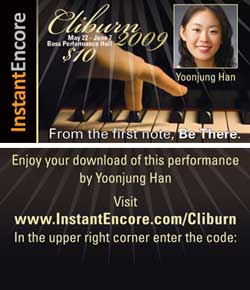
- An InstantEncore concert card offering a music download.
Meanwhile, I had the pleasure of meeting some wonderful engineers and they had a really powerful search engine specific for classical music that resulted in a high-end jukebox called Maestro. It had originally been created to help catalog vast CD collections, like that of our chairman/CEO. I was talking to them about how sometimes as a performer you would go to a live event and afterwards people would say “I loved the concert. How can I hear it again? How can I get a recording?” And of course I was always trying to sell some unrelated CD. So I talked to these engineers about this predicament that a lot of musicians always find themselves in, and so we actually created this concept of the “Instant Encore”—where you can take a card at the concert, go home, and download the content that you just heard.
How has InstantEncore evolved from the days of concert cards to now? Instant Encore started with a very powerful search engine that had organized and standardized all classical music meta data, and our objective was to build the tools that would enable fans to connect with the music and artists they love, in a personal, immediate way. We wanted to leverage technology to extend and enhance every aspect of the live concert experience. We are committed to providing the 21st century tools that will save organizations time and money by automatically or quickly powering their digital assets to connect with fans and engage sponsors.
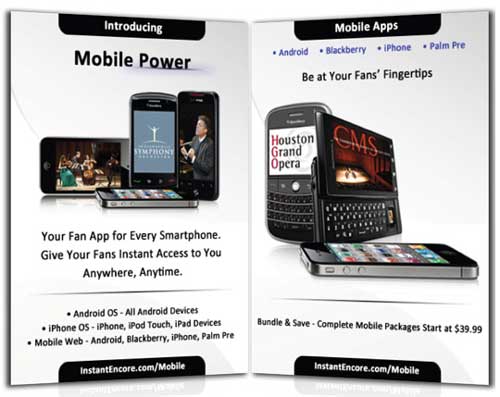
How does the Instant Encore component fit in with an organization’s existing social media presences and organizational website? Our goal is to streamline redundancies and save resources. Right now, you have a lot of people that are trying to update their website, spending a great deal of time developing a content management system internally instead of spending development time and resources on the front end. Then there is the mobile space--if an organization does not have a good web-browsing experience from a smartphone, people will close the site. Then organizations are manually pushing content that is often a PR push to Facebook and then to Twitter as well. So there’s a great amount of time and effort in trying to maintain all these very necessary social network platforms.
Obviously details about classical music can be a nightmare to organize or for data entry. We have a very standardized way—unless it’s a world premiere, it’s all in our search engine’s system. For example, if you start to type in “Beethoven Symphony No. 5”, it’s going to have the opus number and the key and all the movements and you just click on that and it’s automatically transferred. So, you’re never entering all that information yourself, which is 1) time-saving and 2) tagged at the most specific level, which allows people that are not looking specifically for you to find you and you that already know you and want to find you to customize their experience.
Our system is set up so that you as a Partner can enter an event listing in moments in our secure Control Panel. By that one simple event creation in our content management system, it updates in your website with our webbuilder or more advanced API (Application Programming Interface—see the end of this entry for more information). posts to the partner’s social networks, mobile apps, etc. You can do a host of different things—tag your YouTube channel. You can manually upload music for streaming or download purchase. Or you can create a private download code campaign for donors or concertgoers. One of our most valuable features is this web crawler that goes through hundreds of RSS feeds and finds articles specific to arts organizations and tag any article from newspapers or blog. This can automatically appear in your app or website as the latest news, so you’re not having to physically manage your app or site but your content is current.
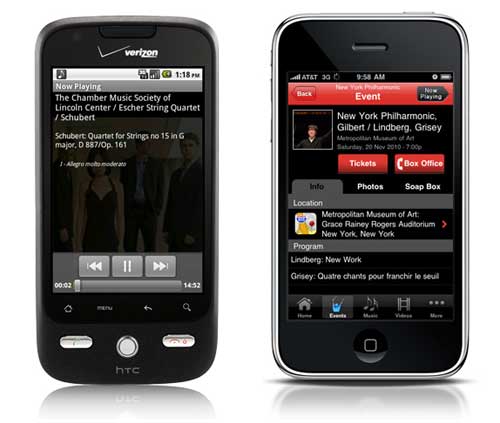 The music player feature on InstantEncore's Android app (left) and the events feature on InstantEncore's iPhone app (right).
The music player feature on InstantEncore's Android app (left) and the events feature on InstantEncore's iPhone app (right).
So basically it’s just a one-stop shop. It’s a digital asset management system where you come to enter your content in one place and it goes to all the platforms that you’re using. We’re just an aggregator and publisher of that content… Our concept was that it should be something that a two-person organization can use our tools and manage and have a very robust, beautiful integrated social media presence or an organization with a budget over 10 million can use the same tool.
Regardless of all the features you offer, many organizations might have trouble getting the rights to use pieces of music or convincing players that a mobile app is somewhere the music should be. What are some of the arguments you can make to convince them that this is something worth doing? I come from the musician/recording side of things, am a current member of the AFM and as a child was a member of AFTRA and SAG, so I certainly appreciate where the musicians are coming from. What I think is important is that, fortunately or unfortunately (however you want to perceive it) we’re in a new period that is such disruptive change, brought on in part by technology and change is always painful. There are new great opportunities but the existing models and the days of residuals in the way that we used to know it, at least right now, are not there. I think it’s really important to actually be very upfront about this. Artists are highly intelligent people and creative people and have wonderful ideas to bring to the marketing and development side of the business. I think it is so important that everyone be a stakeholder charting this new world together.
I think part of this is taking a holistic approach and saying that there are certainly a group of people that are going to want a physical CD’s and there’s people that are going to want to download content. But there’s a certain group of people know who just want what they want, when they want it. We see from our stats that music or videos are increasingly having a very short shelf life. People will often want to hear a new live recording over and over and then they move on and that is it. I often say to my friends and colleagues that you have to have some faith and work together to try things. Every community and every audience is different, but if you don’t have the tools to even explore or try things, that’s very challenging. I think mobile is so essential. People will be accessing the internet via their mobile devices more than from a computer within the next few years. If you don’t have a good user experience to access your content via mobile or any content in it, in my opinion, I think it will be very, very challenging.
You mentioned that you are focusing your research efforts on return on investment in digital media and how orgs can get sponsorship for their technology initiatives. Can you tell me more? Why should anyone care about social media and an integrated digital strategy? Why should anyone care about having a mobile app? I’m a very “nuts and bolts”, frugal person. When I look at some of the organizations that I work with and see how much they’re spending on print material and yet they don’t want to spend a few thousand on a mobile presence, or want to wait a few years to see where this mobile thing goes, I think it is quite alarming. Showing people the return on investment is critical for them to care.
Many organizations we are working with have packaged a digital or mobile sponsorship package and in many cases, new donors or people who were not previously interested in sponsorship at a significant level, are excited to be part of new technology, sponsoring live video streaming on websites and mobile platforms and much more.
It’s built into our platforms—ways for people to feature sponsors, going through their audience to create new audiences, etc. What I’ve found is that I’ve been pushing organizations to think outside of their printed program with a printed logo and think, how can we think outside of the box and take the old ways that we used to monetize and seek corporate sponsors and take this into the digital space? Some organizations have come up with some fabulous things. Whether it’s embedded streaming announcements featuring sponsors, ad spots with sponsors, getting grants to cover new educational and audience development initiatives—various things. They’ve been able to monetize this in new ways, from new sponsors (not cutting out of other things).
I am very excited that Telstra, the telecom company in Australia, hired us to create a premium custom app for the Sydney Symphony that will include live video streaming of ten concerts in their mobile apps and website. This is a win-win for everyone.
How should arts organizations approach technology? There are so many platforms out there, there is so much information and everything’s changing so rapidly. I remember launching the app with the New York Phil and at that time, apps were still—people thought “what the heck is that?” So, the most important thing is to integrate digital media strategy into organizational strategy—into every aspect of decision-making across all departments. It involves PR, it involves marketing, it involves development, it involves operations, the audio recording department, musicians—absolutely everyone. I think that buy-in is essential. I think one of the most important things is just to start small and get permission to try something. If it doesn’t work, don’t let it validate that “this is never going to work” and if it’s a home-run, that doesn’t mean that it’s going to work the next time. It’s important to look at just getting started but with a clear, integrated strategy approach. And really, actually, there’s a lot of fear sometimes when it comes to technology and I think part of what’s been fun to see is that oftentimes, it’s a lot more fun than people necessarily anticipate and I think that that’s been a really rewarding part of what we’re doing.
When Thomas Hampson made his recital available for download and Performance Today, Minnesota Public Radio, and European Public Broadcasting Union announced it on air. We read the comments from people from around the world—from United Arab Emirates, to Germany to California to Wisconsin—about how that music impacted them and how grateful they were for that. I was very honored and proud that some of our tools could be helping to connect the power of his voice and his artistry globally in a way that’s never happened before. I think that’s really what it’s about and instead of feeling more protectionist, as scary as it feels, to embrace democratized access in this engaged age.
More info on Maestro API:
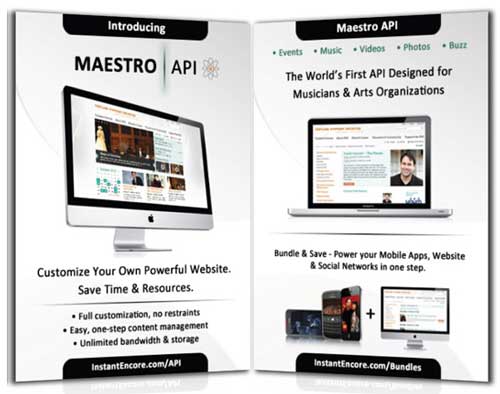
10 Arts and Culture Mobile Apps from 2010
Merely half a day away from the end of the year, today is a great day to reflect on all the different happenings in 2010. One of the big things I have been looking back on is the growth of useful mobile apps for arts and culture audiences and managers. Here is a look at ten of these apps from the past year selected by the Technology in the Arts team and you, our lovely readers:
The Florida Grand Opera | FREE
Available for: iPhone, Android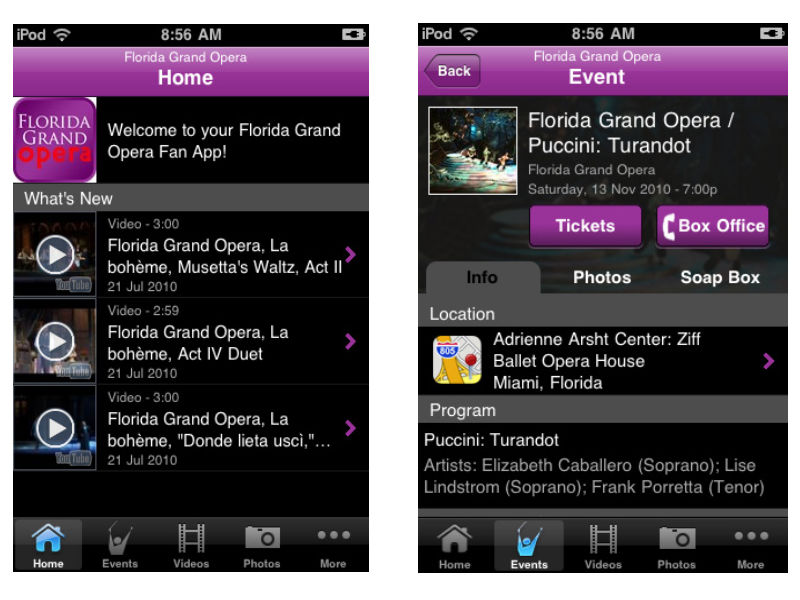 The Breakdown: A great app for the Opera lover in us all, the Florida Grand Opera app offers news about the company, events updates, listings of upcoming performances, and streaming audio of the 2010-2011 season. One aspect of the app I really enjoyed was the videos section, containing a multitude of interviews and performances from the FGO. The only real complaint I have about the app is the necessity to sign up for updates from FGO before being allowed access into the app.
The Breakdown: A great app for the Opera lover in us all, the Florida Grand Opera app offers news about the company, events updates, listings of upcoming performances, and streaming audio of the 2010-2011 season. One aspect of the app I really enjoyed was the videos section, containing a multitude of interviews and performances from the FGO. The only real complaint I have about the app is the necessity to sign up for updates from FGO before being allowed access into the app.
Google Goggles | FREE
Available for: iPhone, Android
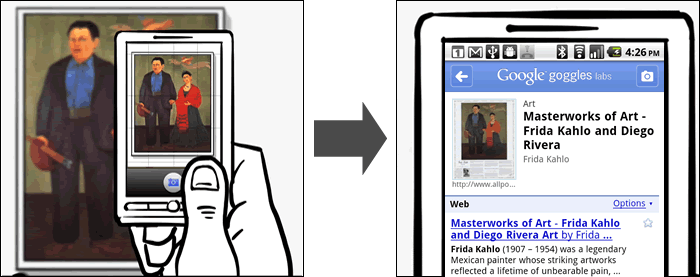
The Breakdown: Google Goggles is a visual search engine built into a mobile app. It utilizes your smartphone's camera to capture and scan an image, object, or landmark and perform a search online to provide information on it. This is a very fun app to play around with and can be very helpful when trying to identify an artwork without a clear label or an unknown landmark. The app is still in beta though and cannot identify anything that is not already currently online in some form.
The L.A. Phil | FREE
Available for: iPhone, Android, & Blackberry
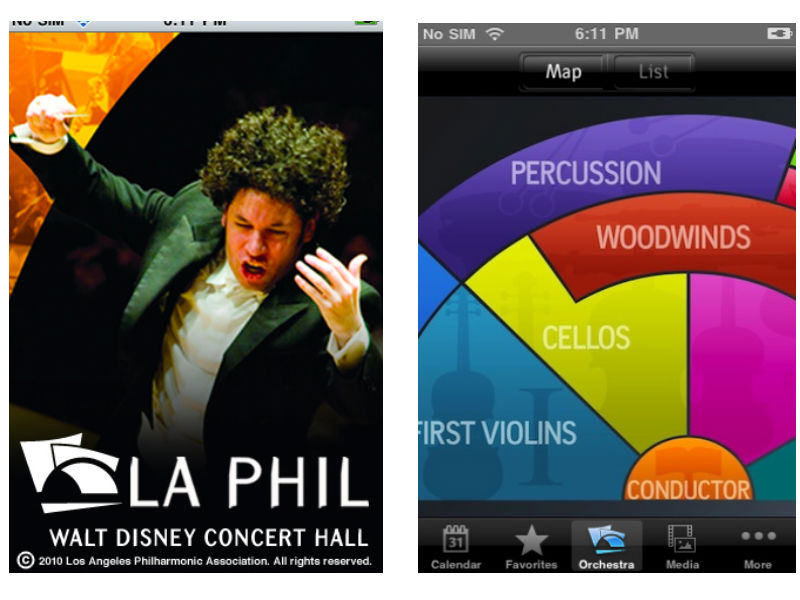 The Breakdown: The LA Philharmonic app has a lot of same offerings as the Florida Grand Opera app in terms of news, media, and listings of events. What sets this app apart is the interactive Orchestra map, laying out the different groups of muscians in the LA Phil. When a user taps on a section of the orchestra, such as First Violins, they are directed to profiles of each musician with in-depth biographies. This app is packed full of great content and an excellent way to learn more about classical music and the people that perform it.
The Breakdown: The LA Philharmonic app has a lot of same offerings as the Florida Grand Opera app in terms of news, media, and listings of events. What sets this app apart is the interactive Orchestra map, laying out the different groups of muscians in the LA Phil. When a user taps on a section of the orchestra, such as First Violins, they are directed to profiles of each musician with in-depth biographies. This app is packed full of great content and an excellent way to learn more about classical music and the people that perform it.
AMNH Explorer | FREE
Available for: iPhone
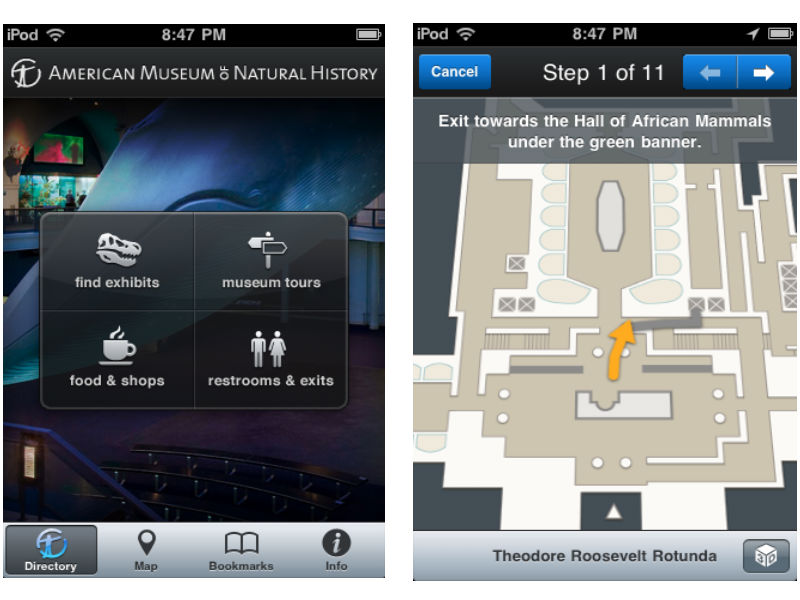 The Breakdown: The Explorer app from the American Museum of Natural History is a great guide for navigating a very large museum. The app acts as a personal in-museum GPS, finding your location and providing information on the exhibits within that area. The app can not only find your location, but provide turn-by-turn directions from one exhibit to the next. This may go against some museum purists love of getting lost within a museum, but on a busy day in a museum packed with visitors this app could be an incredible advantage.
The Breakdown: The Explorer app from the American Museum of Natural History is a great guide for navigating a very large museum. The app acts as a personal in-museum GPS, finding your location and providing information on the exhibits within that area. The app can not only find your location, but provide turn-by-turn directions from one exhibit to the next. This may go against some museum purists love of getting lost within a museum, but on a busy day in a museum packed with visitors this app could be an incredible advantage.
Is This Art? | FREE
Available for: iPhone
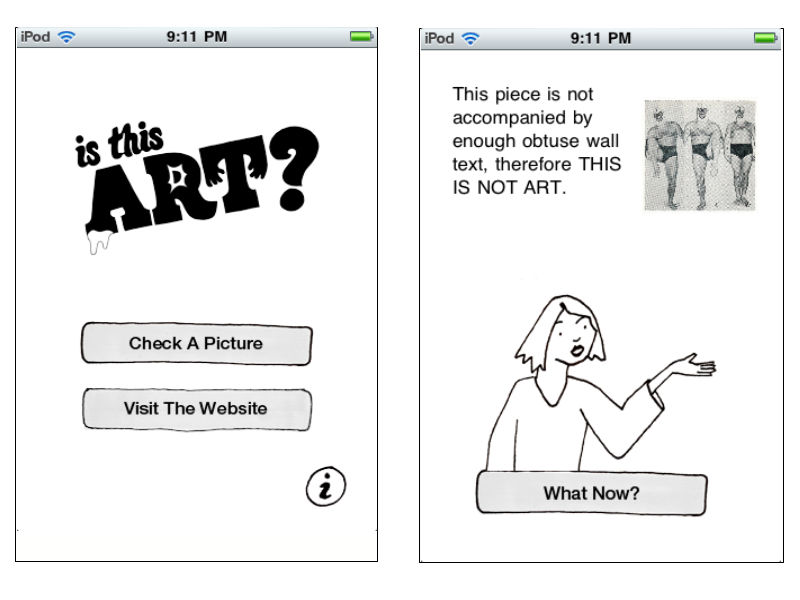 The Breakdown: A fun app from the folks at Deeplocal and the Mattress Factory, Is This Art? is one way to win those age old arguments about what is and isn’t art. Users snap a picture of the art in question and open it within the app to test its validity in the art world. The explanations the app gives are often hilarious such as, "This makes me feel intellectually inferior, therefore THIS IS ART" and, "This piece is not accompanied by enough obtuse wall text, therefore THIS IS NOT ART". All of the images users put to the test can be uploaded to the project's ongoing blog.
The Breakdown: A fun app from the folks at Deeplocal and the Mattress Factory, Is This Art? is one way to win those age old arguments about what is and isn’t art. Users snap a picture of the art in question and open it within the app to test its validity in the art world. The explanations the app gives are often hilarious such as, "This makes me feel intellectually inferior, therefore THIS IS ART" and, "This piece is not accompanied by enough obtuse wall text, therefore THIS IS NOT ART". All of the images users put to the test can be uploaded to the project's ongoing blog.
Brooklyn Museum Mobile | FREE
Available for: iPhone, Android, & Blackberry
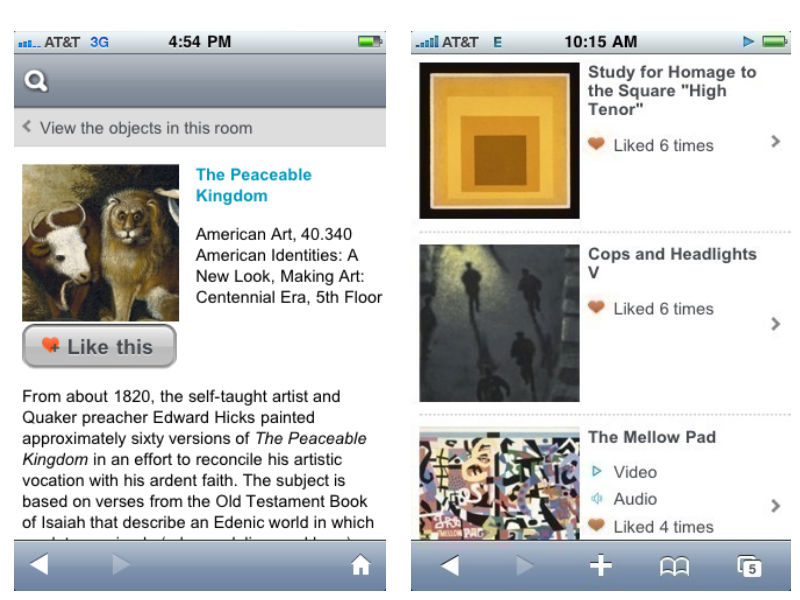
The Breakdown: Another great app for a large museum, Brooklyn Museum Mobile has less of a focus on navigation and more on community and interaction. The app brings in aspects from social media by inviting users to add descriptive tags and/or "like" artworks from the collection. This acts as a recommendation system for other visitors and encourages a more participatory experience. The aspect I like about Brooklyn Museum's offering is that the app runs off of a mobile website, meaning that it is not device exclusive and anyone with a web-enabled device can join in the fun.
The Lighting Handbook | $4.99
Available for: iPhone
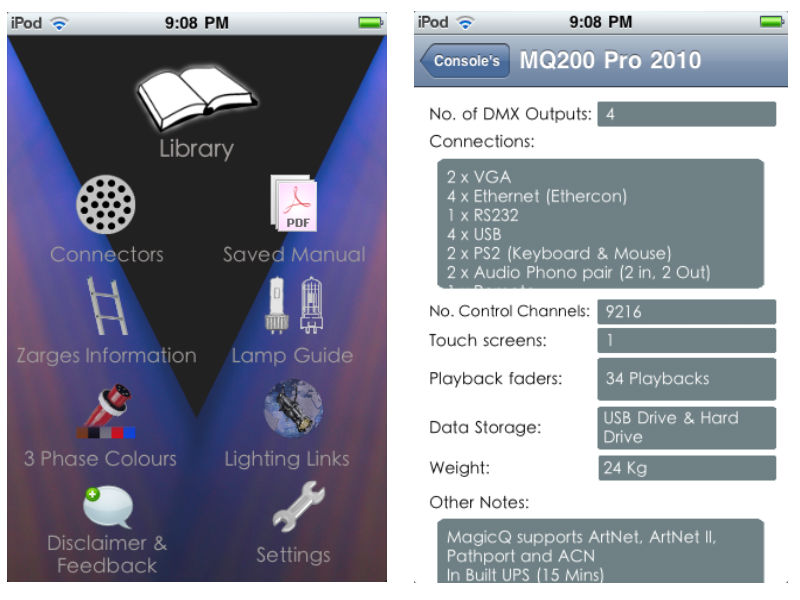 The Breakdown: This is a great app for all of you theater techies. The Lighting Handbook is exactly what it sounds like, an in-depth guide to all things lighting, conveniently in your pocket.
The Breakdown: This is a great app for all of you theater techies. The Lighting Handbook is exactly what it sounds like, an in-depth guide to all things lighting, conveniently in your pocket.
Chicago Gangland Tour | $2.99
Available for: iPhone
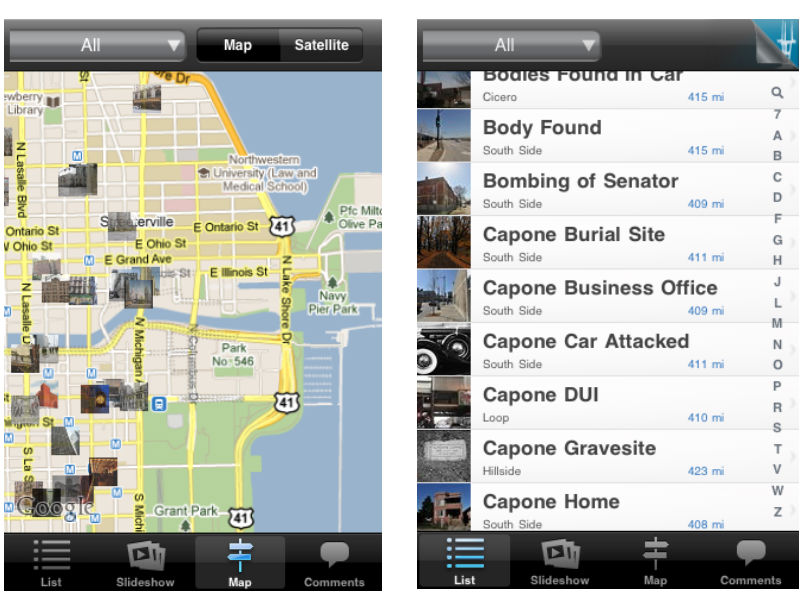
The Breakdown: Ever wanted to walk in the footsteps of famous gangster Al Capone? That's exactly what the Chicago Gangland Tour app helps you do, integrated with google maps to give users a handheld guide for a historical walkthrough of Chicago's mafia history. This app provides info on all the different sites historical relevance and invites users to add their own comments. My favorite aspect of the app is the drop-down menu where results can be sorted by subjects like murders, shootouts, and gangster hideouts.
At The Booth | $0.99
Available for: iPhone, Android
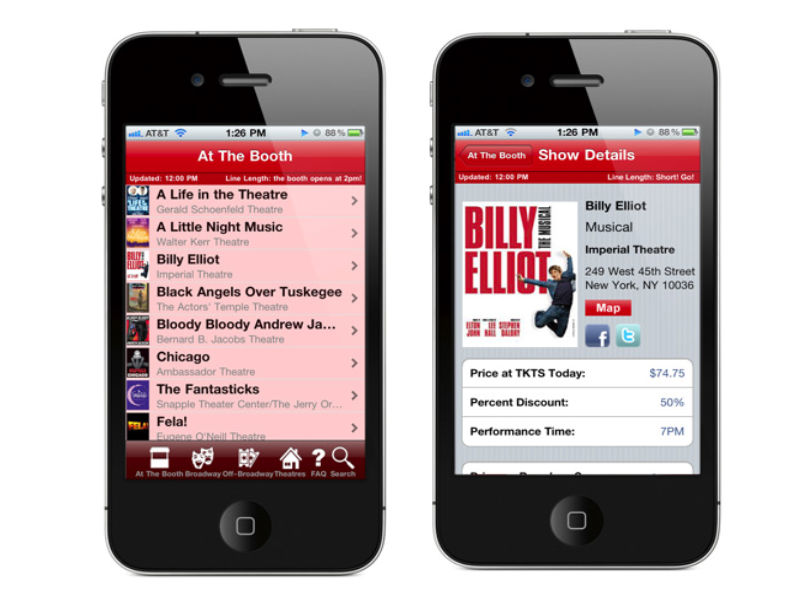 The Breakdown: At The Booth is a full-service app for attendees of Broadway and Off-Broadway shows in New York City. The main page updates with every launch of the app and includes the latest shows and theater locations. For each show the app provides info on the showtimes, ticket prices, discounts, synopses, links to reviews and videos, and nearby restaurants. Listings will appear with a pink undertone to let users know if there are long lines at the theater. The only real complaint I have about the app is that the listings are only viewable in list form, whereas a map option would really assist in seeing all that is available in the immediate area.
The Breakdown: At The Booth is a full-service app for attendees of Broadway and Off-Broadway shows in New York City. The main page updates with every launch of the app and includes the latest shows and theater locations. For each show the app provides info on the showtimes, ticket prices, discounts, synopses, links to reviews and videos, and nearby restaurants. Listings will appear with a pink undertone to let users know if there are long lines at the theater. The only real complaint I have about the app is that the listings are only viewable in list form, whereas a map option would really assist in seeing all that is available in the immediate area.
The Sundance Festival 2010 | $4.99
Available for: iPhone
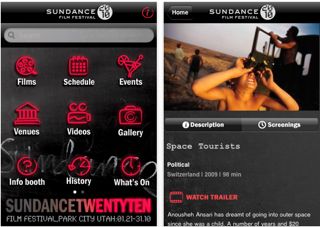
The Breakdown: The Sundance Festival app acts as an online brochure for the annual film festival. In addition to offering videos and reviews on films being shown, the app gives festival attendees real-time updates as to what is happening with the film fest's various events and screenings. The one feature that this app lacks is a way to create custom schedules of screening times and events. This would be invaluable at a festival where multiple things are being offered at once and making the most of the your time requires a lot of planning.
Focus on the data: LSO's Digital Season Brochure
Last year I wrote about the London Symphony Orchestra’s digital season brochure. As technology and environmental concerns cause more printed pieces to go online, the arts industry will see more season brochures go digital. According to a recent Technology in the Arts poll, 56% of arts organizations already have their season brochure online in some form (PDF or interactive).
Last season was the first that they made the brochure, launching it in February of 2009 with their season announcement. Based on its success, they have released another brochure this year with plans to distribute it more widely. Today I have a follow-up with Digital Marketing Manager Jo Johnson about the success of last year’s brochure.
The marketing team at the London Symphony Orchestra chose to make last year’s season brochure after deciding to plan the online and offline elements of our season campaign together. Jo said, “we had produced films to illustrate the season's themes, but it was a few months after the season had first gone on sale, and so felt rather like an afterthought. Also we had decided that we were going to put our season on sale online before we opened to telephone booking, so turning to online channels (email, web and social networks) to send info out to the bookers felt natural. A digital brochure was the obvious choice.”
For newcomers to the digital brochure, it may be hard to know where to get the technology to make the brochure, as well as how much lead time to allow for it. This year symphony again used interactive publication platform Ceros to create their season brochure, complete with audio and video. Other platforms that were suggested in our poll included Issuu and Yudu.
According to Jo, after the art and copy was approved for the print brochure, the digital brochure only took about two additional weeks. “[The print version] needs to be made suitable for online readers (adding some buttons, changing some bits of text to make it obvious that their links, making the images 16:9 ratio so that you can embed a video over it). That's about a week. Then because I don't have Flash skills, the digital brochure company did all the Flash work for me. They were pretty quick, but leave time for changes, testing and sign off. That was about another week.”
Jo found that the brochure was driving traffic primarily to concert pages (where tickets can be purchased). “The top 20 clicked links are all to concerts, with the season opening concert on 20 September being the most clicked.” Using Google Analytics, Jo determined that roughly 1 in 5 viewers played a video, and viewing figures correspond to page numbers (i.e. the least viewed video is last in the brochure). Viewers stayed on the digital season brochure an average of about four minutes. Overall, the 2009/10 digital brochure was viewed 10,870 times. Based on the data she pulled she concluded that the amount of revenue directly from the brochure covered its costs, but that the brochure “played a more of a role in decision making than direct purchasing." She said:
On the financial side, I could see purchases made on our website that had come directly from the digital brochure. Added up, the income was just over the figure it cost to make the brochure. But as with all marketing, I'm also interested in the purchases that were made as a result of someone having the digital brochure, but not directly. At the LSO we talk about multi-channel marketing and CRM, whereby we allow the customer to make his own decision on which method to use to make the final purchase. So although the brochure had embedded links back to the LSO website where tickets can be bought, a customer may have browsed the brochure, seen a concert they like, gone away to chat to a friend about going together, made a decision a week later, and then gone back directly to the website to make the purchase, or called the box office on the phone. In this case I would not have seen the income from his ticket in the analysis I did on the brochure; and this is what I meant when I said 'It's likely it plays more of a role in decision making than direct purchasing.'
When taking on these technological innovations, it’s difficult to know how to measure success. As Jo said in our conversation, “This is the challenge marketers face every day--how to track customers as they hop through our available channels.” Your outreach program or social media site may have paid for itself in tickets, but how do we measure things like brand recognition? Social marketing experts like Charlene Li and David Berkowitz have come out with suggestions, some of which go beyond mere revenue. Jo saw two huge benefits to producing the brochure, beyond its break-even point.
The very fact that we had produced one at all gave the LSO a huge amount of coverage. It was passed around as a 'novelty' item, which people enjoyed looking at, turning the pages, watching the videos, just to see what it did. This is the same kind of benefit as social media brings an organization--people talking about your group. They might be on the other side of the world, they might not come and buy a ticket, but the fact that you have come to their attention is almost as valuable as a ticket sale - in our case it may eventually assist in ticket sales when we go on tour, or on sales of our CDs (our own label). Unfortunately, the "buzz" isn't really trackable in any meaningful sense, other than clicks and views and Retweets. But it still counts.
Lastly, the digital brochure brought a small environmental benefit. We reduced the number of brochures we printed, since we sent it out to people on our database that had email addresses instead of the print in the post. We also used the digital brochure in the information we emailed out to journalists at the season launch, instead of posting them one. Our Managing Director likes to email the digital brochure to prospective festivals and venues abroad as our "flagship" publications, thus saving more paper and postage. I'm sure the effects are negligible in the bigger picture, but any boost to our green credentials helps!
So, is investing time and money worth it for your company? Here are Jo’s thoughts:
Probably the most useful thing I can offer is some thoughts into whether others should follow suit and produce a digital brochure. Here's some:
- A digital brochure should never replace your printed one, but should be complementary to it. A good marketing campaign should have all the online and offline elements planned in together at the same time.
- Personally I think the key to it is to have good content which makes it worthwhile - video content is the obvious one. There are plenty of free options for making a digital brochure out of your PDF, but mostly these don't offer the rich media content like embedded videos and soundclips.
- Make sure you have the mechanisms and a plan in place to market the digital brochure - which can only really be done online. Social networks are ideal, but don't ignore your own website! There's no point in having one if you don't market it - people will not stumble upon it randomly.
- Ideally the digital brochure should be designed with online usage in mind - and possibly independently from the print version. We weren't able to do this wholesale though because of the cost of the designers! We chose the route of adapting the printed version.
Where we are different, we are the same
This post also appears as part of the Arts Marketing Blog Salon hosted by Americans for the Arts.

- Silos belong on farms, not in arts organizations.
As a writer for the Technology in the Arts blog, I am constantly thinking about which topics will appeal to which artistic disciplines, which specialty, which skill level… and on and on. But the more I have to think about the segmentation of the arts management audience, the more I realize how broad many of the issues we discuss are.
A few months ago, I interviewed Alan Cooke of the e-fundraising company Convio, and we talked at length about the problem of organizational silos. In arts organizations, as in any company, conflicts often arise between different departments and may develop into an “us against them” mentality. As arts organizations become more prevalent in the social media space, it becomes easier to see which organizations have truly good internal communication between marketing, communications, box office and development departments.
We also tend to think that orchestra problems are unique to orchestras, theatre problems unique to theatres, and so on. For example, a few months ago I was at an opera conference listening to a presenter from another artistic discipline, when a colleague leaned over and whispered, “Ok, but what does this have to do with opera?” Unsure how to respond, I sort of nodded in agreement, but later, I couldn’t stop thinking about it. True, it didn’t have much to do with opera, but, I would argue, the point of the conference was to learn new things, not to be told about things we already know.
Working in the non-profit world, we usually don’t pay attention to discussions and proposed solutions going on in the corporate world. We don’t think that their solutions will work for us. I’m in a class right now entitled Social Media Analytics, where the students are split up into teams and assigned a major corporation as a client. At first, I expected that the corporations would have a pretty good handle on their social media presence, in terms of who they were reaching, who they were converting and how they were making money from their social media sites. What I found, however, was that the for-profit companies involved in the project are asking a lot of the same questions that I see posted by non-profit arts companies all the time. How do we track audience engagement? How do we convert brand awareness to sales?
Technology, especially social media, is an industry in high flux. It’s easy to think that there’s someone out there with all of the answers, but the truth is we’ve only begun to understand, let alone master the seismic shift in online behavior and the potential of these new tools. We still struggle to find tools that will accurately “read” sentiment from user comments and accurately extract what people are really saying about our brand. We question whether our tracking of sales due to social media is accurate. We wonder how much effort, which platforms, and which campaigns are really worth our time.
One of the things I am looking forward to most at the NAMP Conference is getting this broad perspective across artistic disciplines. Learning from each other is one of the most important things we can do, and I’m looking forward to seeing how arts marketing, as a specialty, has developed in the past year.
Get Your Phil...
The New York Philharmonic has created a subscription series that allows people under age 35 to build their own season package for only $29 per ticket. Subscribers using MyPhil, as the program has been dubbed, get the best available seats in the house at the time of purchase, so the value of the discount fluctuates depending on the seat(s) one is able to secure.
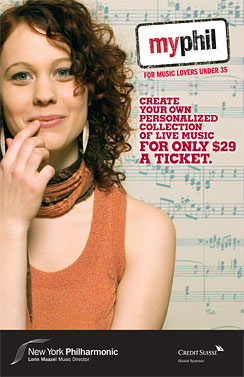
The subscription plan offers extra tickets throughout the season for guests for just $29 and also provides scheduling flexibility should a conflict arise on the date of your ticketed performance. In addition, MyPhil subscribers get a free one-year subscription to Time Out New York magazine.
This is just another example of an arts organization recognizing the unique needs and habits of the 18-35 set. I'm 31 years old, and the thing I appreciate most about plans like this is the ability to select alternate performance dates should a conflict arise. Young people are less and less likely to plan ahead, as we like to keep our social calendars flexible in the off chance that a better opportunity presents itself.
Confession: I have no social calendar. But if I did, I'd like to keep it flexible.













